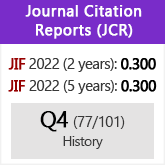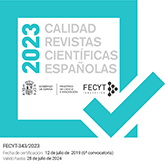Digital sources: a case study of the analysis of the Recovery of Historical Memory in Spain on the social network Twitter
DOI:
https://doi.org/10.3989/chdj.2018.015Keywords:
Methodology, Data mining, Networks analysis, History, TwitterAbstract
The incorporation of digital sources from online social media into historical research brings great opportunities, although it is not without technological challenges. The huge amount of information that can be obtained from these platforms obliges us to resort to the use of quantitative methodologies in which algorithms have special relevance, especially regarding network analysis and data mining. The Recovery of Historical Memory in Spain on the social network Twitter will be analysed in this article. An open-code tool called T-Hoarder was used; it is based on objectivity, transparency and knowledge-sharing. It has been in use since 2012.
Downloads
References
Aragón, P. et al. (2017) "Online network organization of Barcelona en Comú, an emergent movement-party". Computational Social Networks, 4(1), p.8. Available at: http://computationalsocialnetworks.springeropen.com/articles/10.1186/s40649-017-0044-4. https://doi.org/10.1186/s40649-017-0044-4
Barberá, P. & Rivero, G. (2012) "Desigualdad en la discusión política en Twitter". Congreso ALICE.
Bessi, A. & Ferrara, E. (2016) "Social Bots Distort the 2016 US Presidential Election Online Discussion". First Monday, 21(11), pp.1–15. https://doi.org/10.5210/fm.v21i11.7090
Blondel, V.D. et al. (2008) "Fast unfolding of communities in large networks". Journal of Statistical Mechanics: Theory and Experiment, p.6. Available at: http://arxiv.org/abs/0803.0476 [Accessed July 10, 2014]. https://doi.org/10.1088/1742-5468/2008/10/P10008
Castells, M. (2009) Comunicación y Poder Alianza Editorial, ed., Alianza Editorial.
Congosto, M. (2015) "Elecciones Europeas 2014 : Viralidad de los mensajes en Twitter". Revista redes, 26, pp.23–52. https://doi.org/10.5565/rev/redes.529
Congosto, M., Basanta-Val, P. & Sanchez-Fernandez, L. (2017) "T-Hoarder: A framework to process Twitter data streams". Journal of Network and Computer Applications, 83(August 2016), pp.28–39. Available at: http://linkinghub.elsevier.com/retrieve/pii/S1084804517300486. https://doi.org/10.1016/j.jnca.2017.01.029
Congosto, M.L. (2016) Caracterización de usuarios y propagación de mensajes en twitter en el entorno de temas sociales. Universidad Carlos III. Available at: http://e-archivo.uc3m.es/bitstream/handle/10016/22826/tesis_maria-luz_congosto_martinez_2016.pdf?sequence=1.
Conover, M.D. et al. (2010) Political "Polarization on Twitter". Networks, pp.89–96.
Ferrara, E. (2017) "Disinformation and social bot operations in the run up to the 2017 french presidential election". First Monday, 22(8). https://doi.org/10.5210/fm.v22i8.8005
Ferrara, E. et al. (2016) "The Rise of Social Bots". Communications of the ACM, 59(7), pp. 96-104. Available at: http://arxiv.org/abs/1407.5225%0A. https://doi.org/10.1145/2818717
Fletcher, R. et al. (2018) "Measuring the reach of fake news and online disinformation in Europe". Factsheets Reuters Institute (February), pp.1–10. Available at: https://reutersinstitute.politics.ox.ac.uk/sites/default/files/2018-02/Measuring%20the%20reach%20of%20
Gayo-Avello, D. (2011) "Don't turn social media into another "Literary Digest" poll". Communications of the ACM, 54(10), pp.121–128. Available at: http://dl.acm.org/citation.cfm?doid=2001269.2001297 [Accessed March 1, 2012]. https://doi.org/10.1145/2001269.2001297
González-Bailón, S., Borge-Holthoefer, J. & Moreno, Y. (2013) "Broadcasters and Hidden Influentials in Online Protest Diffusion". American Behavioral Scientist, (0).
Grabowicz, P. a et al. (2012) "Social features of online networks: the strength of intermediary ties in online social media". PloS one, 7(1), p.e29358. Available at: http://www.pubmedcentral.nih.gov/articlerender.fcgi?artid=3256152&tool=pmcentrez&rendertype=abstract [Accessed March 2, 2012].
Hanna, A. et al. (2011) "Mapping the Political Twitterverse : Candidates and Their Followers in the Midterms". Artificial Intelligence, pp.510–513.
Hanneman, R. a. & Riddle, M. (2005) "Introduction to Social Network Methods: Table of Contents". Riverside, CA: University of California, Riverside ( published in digital form at http://faculty.ucr.edu/~hanneman/ ), 13(October). Available at: http://www.faculty.ucr.edu/~hanneman/nettext/.
Hirsch, J.E. (2005) "An index to quantify an individual's scentific research output". Proc Natl Acad Sci U S A, 102(46), pp.16569–16572. Available at: http://www.ncbi.nlm.nih.gov/pubmed/16275915. https://doi.org/10.1073/pnas.0507655102 PMid:16275915 PMCid:PMC1283832
Huberman, B.A., Romero, D.M. & Wu, F. (2009) "Social networks that matter : Twitter under the microscope". First Monday 14(1). Available at SSRN: http://ssrn.com/abstract=1313405.
Iacus, S.M. (2015) "Automated Data Collection with R - A Practical Guide to Web Scraping and Text Mining". Journal of Statistical Software, 68(Book Review 3). Available at: http://www.jstatsoft.org/v68/b03/.
Jungherr, A., Jurgens, P. & Schoen, H. (2011) "Why the Pirate Party Won the German Election of 2009 or The Trouble With Predictions: A Response to Tumasjan, A., Sprenger, T. O., Sander, P. G., & Welpe, I. M. 'Predicting Elections With Twitter: What 140 Characters Reveal About Political Sentiment'." Social Science Computer Review. Available at: http://ssc.sagepub.com/cgi/doi/10.1177/0894439311404119 [Accessed April 11, 2012].
Leskovec, J., Lang, K.J. & Mahoney, M. (2010) "Empirical comparison of algorithms for network community detection". Proceedings of the 19th international conference on World wide web - WWW '10, p.631. Available at: http://portal.acm.org/citation.cfm?doid=1772690.1772755. https://doi.org/10.1145/1772690.1772755
Livne, A. et al. (2010) "The Party is Over Here : Structure and Content in the 2010 Election". Proceedings of the Fifth International AAAI Conference on Weblogs and Social Media, pp.201–208.
Morales, A. J. et al. (2015) "Measuring political polarization: Twitter shows the two sides of Venezuela". Chaos: An Interdisciplinary Journal of Nonlinear Science, 25, p.33114. Available at: http://scitation.aip.org/content/aip/journal/chaos/25/3/10.1063/1.4913758. https://doi.org/10.1063/1.4913758
Newman, M.E.J. (2005) "Power laws, Pareto distributions andZipf's law". Contemporary physics, 46(5), pp.323–351. Available at: http://arxiv.org/abs/cond-mat/0412004. https://doi.org/10.1080/00107510500052444
Newman, M.E.J. & Girvan, M. (2004) "Finding and evaluating community structure in networks". Physical Review E, 69(2), pp.1– 16. Available at: http://arxiv.org/abs/cond-mat/0308217%0A. https://doi.org/10.1103/PhysRevE.69.026113 PMid:14995526
Noelle-Neumann, E. (1995) "La Espiral del silencio: opinión pública: nuestra piel social". Paidós comunicación, 62, p.331. Available at: http://biblioteca.uoc.edu/llibres/19198.htm.
Page, L. et al. (1998) "The PageRank Citation Ranking: Bringing Order to the Web". World Wide Web Internet And Web Information Systems, 54(1999–66), pp.1–17. Available at: http://ilpubs.stanford.edu:8090/422.
Pe-a-López, I., Congosto, M. & Aragón, P. (2014) "Spanish Indignados and the evolution of the 15M movement on Twitter: towards networked para-institutions". Journal of Spanish Cultural Studies, 15(1–2), pp.189–216. https://doi.org/10.1080/14636204.2014.931678
Romero, D.M. & Huberman, B.A. (2011) "Influence and Passivity in Social Media". In Machine learning and knowledge discovery in databases. Springer Berlin Heidelberg, pp. 18–33. https://doi.org/10.1145/1963192.1963250
Stella, M., Ferrara, E. & De Domenico, M. (2018) Bots sustain and inflate striking opposition in online social systems, pp.1–10. Available at: http://arxiv.org/abs/1802.07292.
Toret, J., Calleja, A., Miró, Ó. M., Aragón, P., Aguilera, M., & Lumbreras, A. (2013) Tecnopolítica: la potencia de las multitudes conectadas. El sistema red 15M , un nuevo paradigma de la política distribuida. Universitat Oberta de Catalunya, Internet Interdisciplinary Institute, Working Paper Series RR13-001.
Wang, Y., Li, Y. & Luo, J. (2016) "Deciphering the 2016 U.S. Presidential Campaign in the Twitter Sphere: A Comparison of the Trumpists and Clintonists". Proceedings of the Tenth International AAAI Conference on Web and Social Media (ICWSM), (Icwsm), pp.723–726. Available at: http://arxiv.org/abs/1603.03097.
Published
How to Cite
Issue
Section
License
Copyright (c) 2019 Consejo Superior de Investigaciones Científicas (CSIC)

This work is licensed under a Creative Commons Attribution 4.0 International License.
© CSIC. Manuscripts published in both the printed and online versions of this Journal are the property of Consejo Superior de Investigaciones Científicas, and quoting this source is a requirement for any partial or full reproduction.All contents of this electronic edition, except where otherwise noted, are distributed under a “Creative Commons Attribution 4.0 International” (CC BY 4.0) License. You may read here the basic information and the legal text of the license. The indication of the CC BY 4.0 License must be expressly stated in this way when necessary.
Self-archiving in repositories, personal webpages or similar, of any version other than the published by the Editor, is not allowed.

















